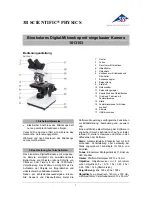
5
10. Changing magnification.
a. Magnification is changed by rotating objective turret until a different objective lens is moved into
optical path. Always turn turret until you hear the “click”, indicating that lens is properly indexed.
Otherwise, you will not be able to see anything when looking through the microscope.
b. Standard lenses provided with your microscope are a widefield 10x eyepiece, 4x, 10x, and 40x
objectives. See chart below for specifications on objectives.
Objective Specification Chart
Objective
N.A.
Color Code
Ring
Field of
View
Working
Distance
Magnification with
WF10X eyepiece
4X
0.10
Red
4.5mm
10.3mm
40X
10X
0.25
Yellow
1.8mm
8.5mm
100X
40X retractable
0.65
Blue
0.45mm
0.5mm
400X
c. Also note that each objective has a color ring, which permits you to instruct changes in magnification
by referring to an easily observed color rather than to a number.
d. The microscope has been parfocalled at the factory, which allows easy change from one
magnification to another, requiring little or no adjustment of the fine focus knobs.
e. As magnification is increased, the field of view (area of specimen seen through the microscope) will
decrease. That is why it is easier to find the specific area of interest on the specimen by starting with
the lowest 4x objective lens, before increasing magnification with the 10x or 40x objective lens.
f.
NOTE: Care must be taken when rotating the 40x objective into place. This lens has a spring
retractable mechanism which retracts slightly into its housing if the front of the lens strikes the
specimen slide. With fine focus adjustment at mid-range, the rack stop has been adjusted at the
factory to assure the 40x lens will clear the thickness of a normal specimen slide and cover slip.
However, if the rack stop has been improperly adjusted, or if using a thicker than normal slide or
cover slip, moving the 40x lens too quickly or carelessly could cause damage to the front lens
element or to the slide.
g. Do not let the front lens element come into contact with a wet slide surface, as prolonged contact with
any moisture could damage the lens. If lens is exposed to moisture, promptly wipe with soft tissue to
remove moisture.
MAINTENANCE
WARNING: For your own safety, turn switch to OFF position and remove electrical plug from power
source.
1. OPTICAL MAINTENANCE
Do not attempt to disassemble any lens components. Consult a microscope service technician when any
repairs not covered by instructions are needed.
Prior to cleaning any lens surface, brush dust or dirt off lens surfaces using a camel hair brush or use air
to blow dust and lint off surfaces. Use of compressed air in a can, available at any computer supply
store, is a good source of clean air.
Do not remove eyepieces or objective lenses to clean. Clean only the outer lens surface. Breath on lens
to dampen surface, then wipe with lens paper or tissue or use a cotton swab moistened with distilled


























